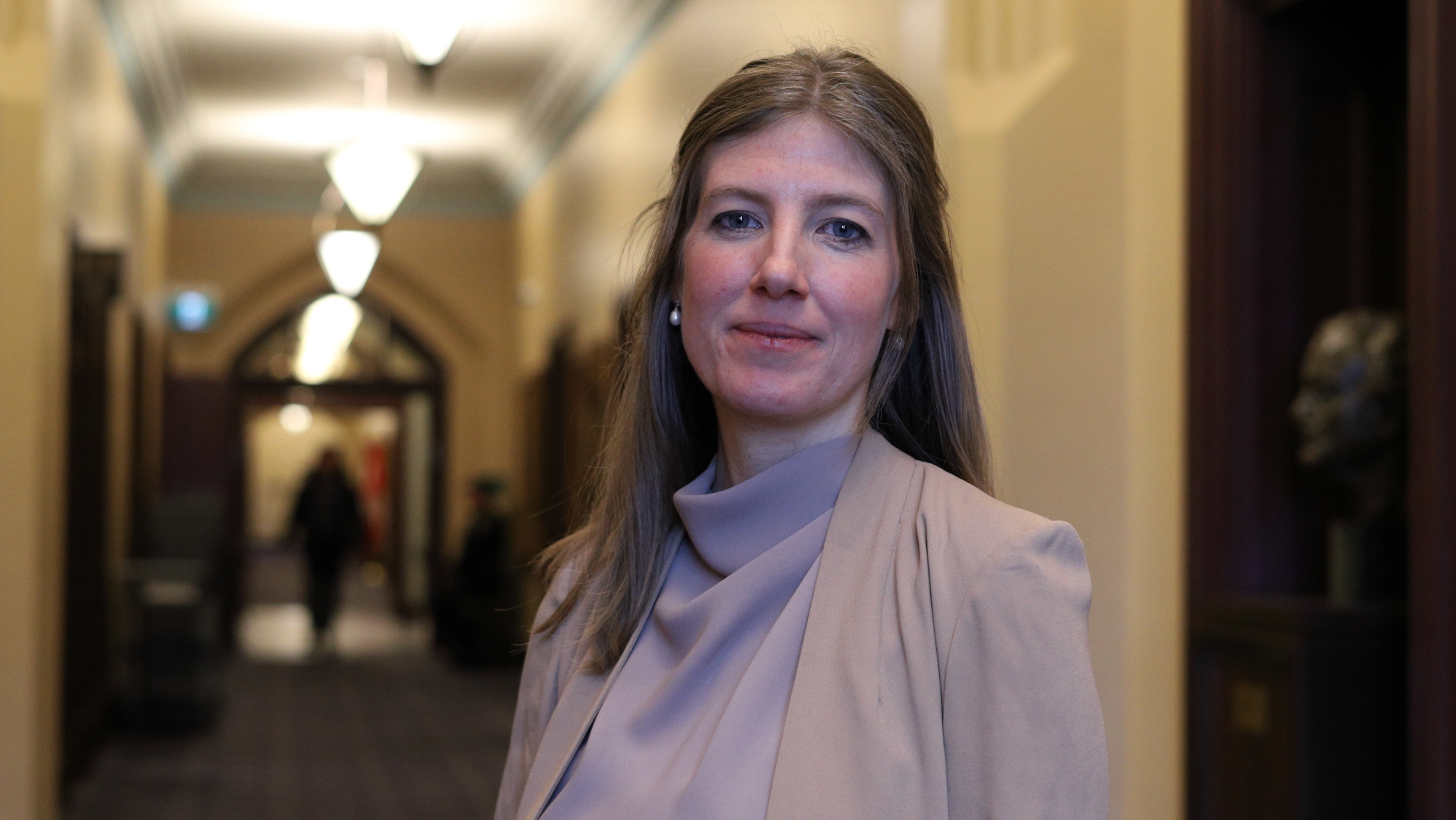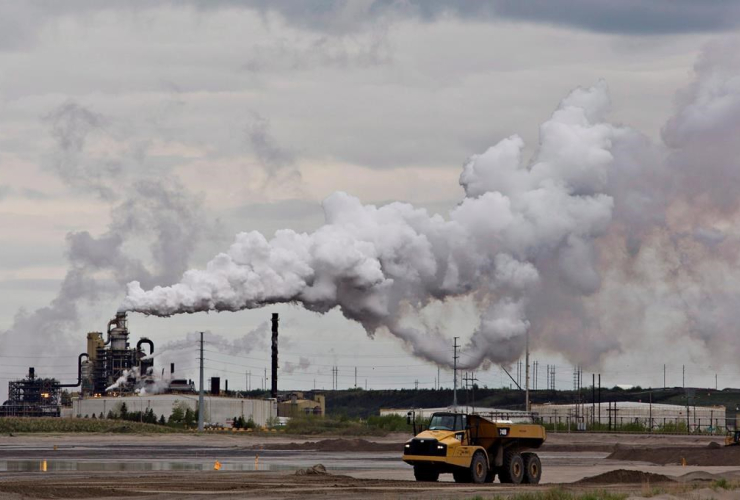MPs are questioning the federal government about its sizable investments in carbon capture following new research on the state of the technology in Canada.
In question period Friday, NDP MP Laurel Collins said the Liberals’ investment in carbon capture is a “flawed approach” and a direct result of them “listening to Big Oil.”
Carbon capture, utilization and storage (CCUS) — whereby climate-warming pollution is captured directly from industrial processes — is lauded by some as a key component of addressing the climate crisis and criticized by others for being a costly distraction that risks locking in fossil fuel use for decades to come.
Carbon capture technology will not be able to help the oil and gas industry hit its climate targets because it’s too costly and takes too long to build, according to a new report by the International Institute for Sustainable Development (IISD). MPs from the Bloc Québécois, Green Party and NDP made hay with the report’s findings and took aim at the federal government on Feb. 10, one day after its release.
“If you want to make good climate policy, stop listening to oil and gas lobbyists,” Collins told MPs during question period before calling on the Liberals to “cancel the carbon capture handouts to Big Oil, and instead invest in real climate solutions.”
The federal government has committed at least $9.17 billion to date for CCUS, according to the IISD report. This includes an investment tax credit worth an estimated $8.6 billion over the next eight years. In comparison, initiatives to reduce methane emissions — a short-lived but powerful greenhouse gas — from the oil and gas sector have only netted $756 million from the federal coffers.
This funding split indicates the government is prioritizing CCUS to decarbonize the oil and gas sector’s emissions over other solutions, the report said.
“CCUS technology is not, on its own, a climate strategy nor is it a silver bullet to combat climate change in Canada,” Keean Nembhard, Natural Resources Minister Jonathan Wilkinson’s press secretary, told Canada’s National Observer in an emailed statement. Nembhard described the technology as “one component of an overarching strategy that seeks to make significant emissions reductions on a pathway to net zero.”
The International Energy Agency’s Net Zero by 2050 report says CCUS must be rapidly scaled up so that by 2050, the world is capturing and storing 190 times more carbon than we are today.
Three of the Intergovernmental Panel on Climate Change’s four pathways to limit global warming to 1.5 C include CCUS, according to its 2018 report. A 2021 report by the Canadian Climate Institute (formerly the Canadian Institute for Climate Choices) similarly put carbon capture technology in the mix for pathways designed to meet Canada’s 2030 and 2050 emissions reduction targets.
CCUS was also identified as one of the most costly and least effective options to address climate change in the IPCC’s latest report. The IPCC is a scientific group assembled by the United Nations that issues reports detailing the causes and state of climate change, its impacts and what can and should be done to combat it. Carbon capture technology is widely said to be an important tool to decarbonize high-emitting sectors like steel and cement production, where few options exist.
Environmental groups frequently point out that CCUS does nothing to address the 80 per cent of climate-warming pollution emitted when we burn fossil fuels in vehicles or heat buildings, and when used on oil and gas sector facilities, the technology can lock in fossil fuel use at a time when scientists warn the world must phase out oil, coal and gas in favour of renewable sources of energy and low-carbon alternatives.
“The narrative around carbon capture and storage relies on the notion that we'll keep producing oil and gas in Canada, that we can do it in a way that somehow makes it … better, greener, safer and more ethical, which is all nonsense,” Green Party Leader Elizabeth May told Canada’s National Observer in an interview.
“Chrystia Freeland should have a look (at this report) before putting another penny into carbon capture and storage.”
Conservative environment critic Gérard Deltell declined a request for comment.
“Independent and scientific data worldwide have shown all the pitfalls of this immature technology — and the government chose to ignore it,” Bloc Québécois MP Monique Pauzé said in an emailed statement to Canada’s National Observer.
“The IISD report confirms that in Canada, 70 per cent of captured carbon is used to scrape the bottom of aging oilfields,” said Pauzé. Injecting captured carbon dioxide (CO2) into mature oil wells has been standard practice for decades, and the sale of CO2 for this purpose helps companies offset the high cost of carbon capture technology.
“More production, always, that’s what the industry is doing with taxpayers’ money,” said Pauzé. “Citizens should be outraged by such recklessness.”
The solution, she said, is to instead channel those public funds into renewable technologies. With oil and gas companies raking in record profits, they should be the ones investing in carbon capture technology, Collins said after question period on Friday.
“The oil and the oil and gas lobby are the ones who push the government into creating these billions of dollar handouts,” and should be excluded from the tax credit, said Collins. “They should be paying for their own pollution.”
The country’s seven operational CCUS facilities capture roughly 3.5 million tonnes of CO2 per year, according to the IISD report. Five of those are related to the oil and gas sector.
Investment, research and development of CCUS projects will help to improve the technology and drive down its future costs, said Nembhard. “Therefore, progress in CCUS technology needs to be viewed through the lens of the complexity of developing new technological innovations at a pre-commercial demonstration stage.”
He noted the department will continue talks with provinces, territories and industry on the best ways to promote the growth of CCUS in Canada.
Natasha Bulowski / Local Journalism Initiative / Canada’s National Observer
Carbon capture is an oil
Carbon capture is an oil industry boondoggle, smoke & mirrors. It is not proven on a large scale, is costly and as the article points out will do little to achieve Canada's climate warming mitigation goals. The oil lobbyists tout the carbon capture approach in the same manner as cigarette companies pushed "low-nicotine" cigarettes - a marketing ploy to keep doing what they are doing.
Canada used to rely on the
Canada used to rely on the expert, impartial and unbiased advice from a capable civil service. Kevin Taft has written about the threat we now face to our democracy and to the planet in his 2017 book "Oil's Deep State". I kept wondering why governments keep making the wrong choices such as small nuclear reactors and CCUSA. It's because that's what the lobbyists want.
Canada might have its own healthcare system but we haven't been able to do anything about Lyme and tick-borne diseases because two infectious disease doctors head the Public Health Agency of Canada. They owe their allegiance and take their direction form AMMI Canada and the big sister 13,000 member private organization, the infectious Diseases Society of America {IDSA] who colluded with the long-term disability insurance industry after they red-flagged Lyme to be too expensive to treat. The insurance industry has learned it can control medicine if it can control the medical guidelines. Lyme the ignored epidemic of Lyme has been swept under the table. Drs. Howard Njoo and Tam are lobbyists for the IDSA guidelines that limit treatment for Lyme to 10 days with a single bacteriostatic agent regardless of the stage of the disease. They deny the existence of chronic complex disseminated Lyme despite volumes of published evidence that their conclusions are wrong.
Keean Nembhard, Natural
Keean Nembhard, Natural Resources Minister Jonathan Wilkinson’s press secretary: "Investment, research and development of CCUS projects will help to improve the technology and drive down its future costs."
Messrs. Wilkinson and Nembhard should look into the efficacy of CCS in the oilsands. And stop pretending that the necessity of CCS for cement and steel also makes it essential for energy production. And stop snowing Canadians.
The Pembina Institute acknowledges that in the oilsands sector "most CO2 is emitted in low concentration streams, and the efforts to capture it will be challenging and expensive."
CCS captures a tiny fraction of emissions at high cost.
Where CO2 sources are small or diffuse, e.g., in the oilsands apart from upgraders, CCS is not economical or practical.
The Pembina Institute estimates that "full deployment of CCUS in all high-concentration streams could result in a decrease of c 7 Mt CO2e annually, which equates to 8% of total oilsands emissions."
Tens of billions of public dollars out the window to capture a small fraction of total upstream emissions. Of course, reducing upstream emissions does nothing to cut the 80–90% of emissions generated from a barrel of oil downstream at the consumer end.
CCS merely perpetuates the oil industry. Fossil fuels for longer means more emissions, not less.
As per 2022 Pembina Institute "Getting on Track" report, heaters and boilers generate low-concentration CO2 streams. The only practical CCS application in the oilsands is hydrogen production plants associated with upgraders:
The cost and effectiveness of CCS depends on several factors, including the size of the waste stream and the CO2 concentration. For carbon capture to be economical/practical, CO2 concentration and volume need to meet minimum requirements. It is more expensive and less worthwhile to try to capture CO2 from small or diffuse CO2 sources. In case of many small or diffuse CO2 sources, total emissions may be high, but CCS is not economical or practical. Low-concentration CO2 streams incur high compression costs. Distributed in situ projects (over a wide area) also incur high transportation costs. Thus, in situ projects are at a double disadvantage.
In the oilsands, upgrader hydrogen plants (hydrogen production from natural gas) have high-CO2 (16-18%) streams. In situ projects (natural gas combustion --> steam generation: steam boilers and cogeneration plants for SAGD; large gas-fired turbines, boilers, and heaters) have low-concentration (4-8%) CO2 streams.
CCS is practical only for upgrader hydrogen production plants, but much more expensive and less likely for in situ projects. CO2 from small or diffuse sources like vehicles, heavy diesel powered machinery and trucks, tailings ponds, and mine deposits cannot be captured at all.






Comments